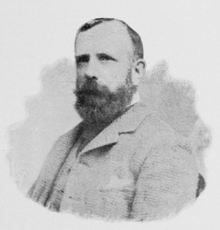John Abercromby, 5th Baron Abercromby
John Abercromby, 5th Baron Abercromby (15 January 1841 – 7 October 1924)[1] was a Scottish soldier[2] and archaeologist.[3]
The Lord Abercromby | |
|---|---|
| 5th Baron Abercromby | |
 | |
| Predecessor | George Abercromby, 4th Baron Abercromby |
| Successor | Title extinct |
| Born | John Abercromby 15 January 1841 Logie, Perthshire, Scotland |
| Died | 7 October 1924 (aged 83) Edinburgh, Midlothian, Scotland |
| Spouse(s) | Adele von Heidenstern
( m. 1876; div. 1879) |
| Issue
The Hon. Edla Nasos | |
| Parents | George Abercromby, 3rd Baron Abercromby Louisa Penuel Forbes |
Career
Abercromby was the son of George Abercromby, 3rd Baron Abercromby, and Louisa Penuel Forbes,[4] and had two brothers and a sister. He was a Lieutenant with the Rifle Brigade. He graduated from the University of Edinburgh with an honorary Doctorate of Law (LLD). On 3 October 1917, following the death of his elder brother George, he succeeded as the fifth Lord Abercromby.
After leaving the army in 1870 he devoted himself to languages, travel, and folklore. In 1904 he introduced the term beaker into the archaeological lexicon to describe the copper age drinking vessels being found all over western Europe.[5] He supported the Society of Antiquaries of Scotland and served as its president from 1913 to 1918. His will provided for the foundation of the Abercromby Chair of Archaeology at Edinburgh University, a post occupied by Vere Gordon Childe and Stuart Piggott.[6]
He is buried in Dean Cemetery in Edinburgh at its east side, close to the main entrance.
Family
Abercromby married his Swedish cousin, Adele Wilhelmina Marika von Heidenstern, on 26 August 1876. They had one daughter, Edla Louisa Montague Abercromby (b. 1877), who married Georges N. Nasos in 1906. They divorced in 1879. As he had no son, the Barony of Abercromby became extinct on his death.
Works
- A trip through the Eastern Caucasus: with a chapter on the languages of the country (London: Edward Stanford, 1889), online
- The pre- and proto-historic Finns, both Eastern and Western: with the magic songs of the west Finns, Grimm Library, 9-10, 2 vols (London: Nutt, 1898), vol. 1, vol. 1, vol. 2, vol. 2[7]
- A study of the Bronze Age pottery of Great Britain and Ireland and its associated grave-goods, 2 vols (Oxford: Clarendon Press, 1912), vol. 1, vol. 2
References
- thePeerage.com
- ‘ABERCROMBY’, Who Was Who, A & C Black, 1920–2007; online edn, Oxford University Press, Dec 2007
- "Abercromby, John Abercromby, baron, 1841-1924 | The Online Books Page". onlinebooks.library.upenn.edu. Retrieved 2020-05-03.
- "John Abercromby British Army officer: Latest News, Videos and Photos of John Abercromby British Army officer | Times of India". The Times of India. Retrieved 2020-05-03.
- ""Lord John Abercromby"". collections.ed.ac.uk. Retrieved 2020-05-03.
- SHARPE (Publisher.), John (1830). Sharpe's Peerage of the British Empire exhibiting its present state and deducing the existing descents from the ancient nobility of England, Scotland and Ireland.
- The Athenaeum. J. Lection. 1912.
- "The tradition of archaeology at Edinburgh". The University of Edinburgh. Retrieved 2020-05-03.
- Much of this material was first published as a series of articles in Folklore: J. Abercromby, 'Magic Songs of the Finns' Folklore, 1 (1890), 17-46, 331-48; 2 (1891), 31-49; 3 (1892), 49-66; 4 (1893), 27-49.
External links
| Wikisource has original works written by or about: John Abercromby, 5th Baron Abercromby |
- Works by or about John Abercromby, 5th Baron Abercromby at Internet Archive
- Portraits of John Abercromby, 5th Baron Abercromby at the National Portrait Gallery, London

| Peerage of the United Kingdom | ||
|---|---|---|
| Preceded by George Abercromby |
Baron Abercromby 1917–1924 |
Extinct |